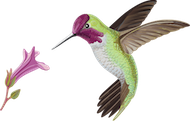Milkweed flowers are unique in that unlike most flowering plants, the pollen of milkweed cannot be collected as individual grains. Instead, hundreds of pollen grains are packaged into pouches which need to be carried to another milkweed plant. How does this happen? Without getting too technical, as an insect crawls over an individual flower, one of its legs slips into the reproductive chamber and gets caught in a “pinch trap” mechanism. When the insect pulls its leg upward, the pouch that contains the pollen snags on to it. The insect then crawls or flies away to continue foraging with the pouch still attached to its leg. Eventually this same leg, with the pollen pouch attached, slips into another milkweed plant’s reproductive chamber. Hopefully for the milkweed, the pollen pouch will then dislodge and pollenate the blossom’s stigma.
Foot note: Both the European honey bee – Apis mellifera, and the Tropical milkweed – Asclepias curassavica are not native to California. The honey bee is here to stay but we encourage the planting of native milkweed. Asclepias curassavica is in the process of being phased-out of the Gottlieb Native Gardenand and being replaced with Narrowleaf milkweed – Asclepias fascicularis.

